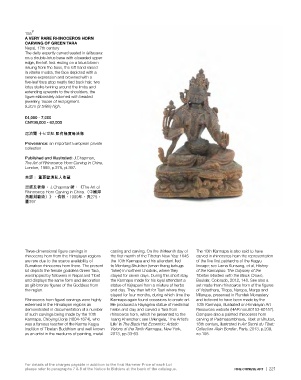Page 223 - Bonhams Chinese Art NYC Nov 9 2017
P. 223
155 Y
A VERY RARE RHINOCEROS HORN
CARVING OF GREEN TARA
Nepal, 17th century
The deity expertly carved seated in lalitasana
on a double-lotus base with a beaded upper
edge, the left foot resting on a lotus bloom
issuing from the base, the left hand raised
in vitarka mudra, the face depicted with a
serene expression and crowned with a
five-leaf tiara atop neatly tied back hair, two
lotus stalks twining around the limbs and
extending upwards to the shoulders, the
figure elaborately adorned with beaded
jewellery, traces of red pigment.
9.2cm (3 5/8in) high.
£4,000 - 7,000
CNY36,000 - 62,000
尼泊爾 十七世紀 犀角綠度母法像
Provenance: an important European private
collection
Published and Illustrated: J.Chapman,
The Art of Rhinoceros Horn Carving in China,
London, 1999, p.275, pl.397.
來源: 重要歐洲私人收藏
出版及著錄: J.Chapman著,《The Art of
Rhinoceros Horn Carving in China (中國犀
角雕刻藝術)》,倫敦,1999年,頁275,
圖397
Three-dimensional figure carvings in casting and carving. On the thirteenth day of The 10th Karmapa is also said to have
rhinoceros horn from the Himalayan regions the first month of the Tibetan New Year 1645 carved in rhinoceros horn the representation
are rare due to the scarce availability of the 10th Karmapa and his attendant fled of the five first patriarchs of the Kagyu
Sumatran rhinoceros horn there. The present to Mentang Shuktser (sman thang bzhugs lineage; see Lama Kunsang, et al, History
lot depicts the female goddess Green Tara, ‘tsher) in northern Lhodrak, where they of the Karmapas: The Odyssey of the
worshipped by followers in Nepal and Tibet stayed for seven days. During this short stay, Tibetan Masters with the Black Crown,
and displays the same form and decoration the Karmapa made for his loyal attendant a Boulder, Colorado, 2012, 148. See also a
as gilt-bronze figures of the Goddess from statue of Vajrapani from a mixture of herbs set made from rhinoceros horn of the figures
the region. and clay. They then left for Tsari where they of Vajradhara, Tilopa, Naropa, Marpa and
stayed for four months, during which time the Milarepa, preserved in Rumtek Monastery
Rhinoceros horn figural carvings were highly Karmapa again found occasions to create art. and believed to have been made by the
esteemed in the Himalayan regions as He produced a Hayagriva statue of medicinal 10th Karmapa, illustrated on Himalayan Art
demonstrated in documentation of a number herbs and clay and carved a Tara from Resources website (HAR nos.60153-60157).
of such carvings being made by the 10th rhinoceros horn, which he presented to the Compare also a painted rhinoceros horn
Karmapa, Chöying Dorje (1604-1674), who Tsang Khenchen; see I.Mengele, ‘The Artist’s carving of Padmasambhava, Tibet or Bhutan,
was a famous teacher of the Karma Kagyu Life’ in The Black Hat Eccentric; Artistic 18th century, illustrated in Art Sacré du Tibet:
tradition of Tibetan Buddhism and well known Visions of the Tenth Karmapa, New York, Collection Alain Bordier, Paris, 2013, p.209,
as an artist in the mediums of painting, metal 2013, pp.33-63. no.106.
For details of the charges payable in addition to the final Hammer Price of each Lot
please refer to paragraphs 7 & 8 of the Notice to Bidders at the back of the catalogue. FINE CHINESE ART | 221

